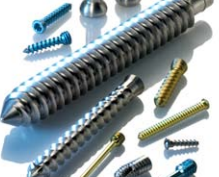Using Thread Whirling to Machine Better Bone Screws

Making parts for medical applications is a growing field that opens up opportunities – and challenges – for CNC shops of all sizes. Orthopedic parts, like bone screws, are good examples. Although these devices appear to be relatively simple, efficiently producing a bone screw that meets the required standards of quality isn’t as easy as it looks.
Because bone screws are typically made of titanium, cobalt chrome or stainless steel and may require helix angles of 15º or more, the traditional method of using a single-point threading tool is seldom effective. The preferred method is thread whirling. As defined by tooling supplier Sandvik Coromant, thread whirling “…consists of feeding a slowly rotating workpiece through a bolted-on whirling adaptor that contains a circular milling tool running at a high rpm.”
While this method improves tool life, other problems still exist including the introduction of chatter that can cause poor surface finish. To further improve tool life and eliminate the chatter problems, Sandvik Coromant developed a product, CoroMill 325, for thread whirling bone screws on a sliding headstock machine. It has a unique layout of inserts positioned at various locations within the whirling unit rather than being evenly spaced. The result is that the harmonics change from insert to insert, thus interrupting chatter to produce a better quality part and prolonged tool life.
Another important factor in applying thread whirling to bone screw machining is to apply high pressure coolant at the cutting area to both reduce heat and efficiently remove chips. The amount of coolant pressure depends on the material, spindle speeds and feed rates. A variable high-pressure coolant system enables you to program the precise pressure for each phase of a machining process.
To learn more about medical machining techniques and the right equipment to help you successfully compete in this market see Considering Medical Parts Machining? Ask Yourself These 7 Questions. Then contact the applications specialists at Gosiger.
 |